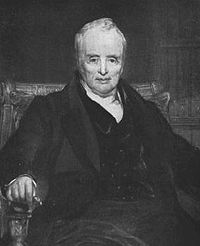William Plunket, 1st Baron Plunket
|
The Right Honourable The Lord Plunket KC PC |
|
|---|---|

Lord Plunket.
|
|
| Lord Chancellor of Ireland | |
|
In office 23 December 1830 – November 1834 |
|
| Monarch | William IV |
| Prime Minister |
The Earl Grey The Viscount Melbourne |
| Preceded by | Sir Anthony Hart |
| Succeeded by | Sir Edward Sugden |
|
In office 30 April 1835 – 1841 |
|
| Monarch |
William IV Queen Victoria |
| Prime Minister | The Viscount Melbourne |
| Preceded by | Sir Edward Sugden |
| Succeeded by | Sir John Campbell |
| Personal details | |
| Born | 1 July 1764 Enniskillen, County Fermanagh |
| Died | 5 January 1854 (aged 89) County Wicklow |
| Nationality | British |
| Political party | Whig |
| Spouse(s) | Catherine MacCausland |
| Alma mater | Trinity College Dublin |
William Conyngham Plunket, 1st Baron Plunket PC, KC (1 July 1764 – 5 January 1854) was an Irish politician and lawyer. He served as Lord Chancellor of Ireland between 1830 and 1834 and again between 1835 and 1841.
The son of a Presbyterian minister, Reverend Thomas Plunket of Dublin, and his wife Mary (née Conyngham), Plunket was born in Enniskillen, County Fermanagh, and educated at Trinity College Dublin. After graduating in 1784, he was admitted as a student at Lincoln's Inn, and was called to the Irish bar three years later.
Plunket was made a King's Counsel in 1795, and three years later was elected to the Irish House of Commons as a Member of Parliament for Charlemont. After the Act of Union was passed, Plunket lost his seat, and failed to be elected to Westminster for the University of Dublin in 1802, but he subsequently became Solicitor-General for Ireland in 1803, a post he held for two years before becoming Attorney-General for Ireland, again for two years. He was appointed a member of the Privy Council of Ireland on 6 December 1805.
In January 1807, he was returned to British House of Commons as a Whig member for Midhurst, representing the constituency for only three months, although he subsequently returned to the House of Commons in 1812 as the member for Dublin University, a seat which he continued to represent until May 1827.
...
Wikipedia
